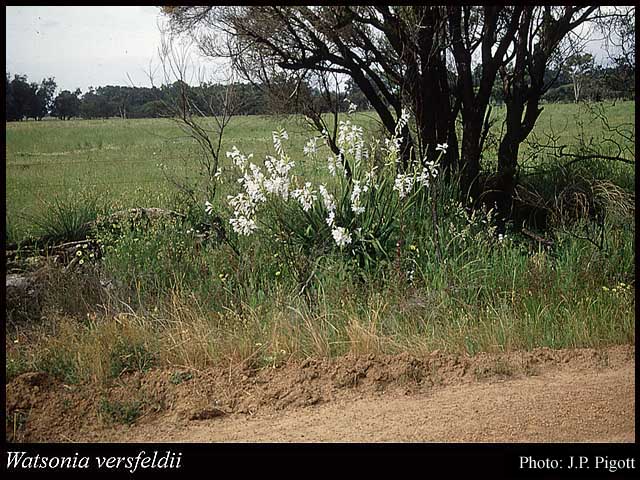- Reference
- Ann.Bolus Herb. 3:139-140 (1922)
- Conservation Code
- Not threatened
- Naturalised Status
- Alien to Western Australia
- Name Status
- Current
Cormous, perennial, herb, 1-1.8 m high. Fl. white/pink, Sep to Nov. Brown clay loam, grey sand over clay, ironstone gravel,. Seasonally wet areas, hillslopes, road verges, vacant land.

Distribution
- IBRA Regions
- Jarrah Forest, Swan Coastal Plain, Warren.
- IBRA Subregions
- Northern Jarrah Forest, Perth, Southern Jarrah Forest, Warren.
- Local Government Areas (LGAs)
- Augusta Margaret River, Chittering, Dardanup, Donnybrook-Balingup, Gosnells, Kalamunda, Manjimup, Victoria Park, Wandering.
Management Notes (for the Swan NRM Region)
General Biology. Growth form. Geophyte. Life form. Annually renewed corm, some dormancy between fire. Reproduction. Offsets, seed. Dispersal. Water, soil, wind. Time to first flowering. 2-3 years. Seedbank persistence. Medium, 1-5 years. Fire response. Generally survives fire. Prolific flowering and seed set follow summer fire.
Additional information. Origin. Southern Africa. History of use/introduction. Garden escape.
Suggested method of management and control. Wipe individual leaves with glyphosate 10% or spray dense infestations 2,2-DPA 10 g/L + Pulse®. Apply just as flower spikes emerge at corm exhaustion. Read the manufacturers' labels and material safety data sheets before using herbicides. For further information consult the Australian Pesticides and Veterinary Medicines Authority to determine the status of permits for your situation or state.
Management Calendar
| Calendar Type | Jan | Feb | Mar | Apr | May | Jun | Jul | Aug | Sep | Oct | Nov | Dec | Comments |
|---|---|---|---|---|---|---|---|---|---|---|---|---|---|
| Dormant | Y | Y | Y | Y | |||||||||
| Active Growth | Y | Y | Y | Y | Y | Y | Y | Y | |||||
| Flowering | Y | Y | Y | ||||||||||
| Germination | Y | Y | Y | ||||||||||
| Optimum Treatment | Y |
Legend: Y = Yes, regularly, O = Occasionally, U = Uncertain, referred by others but not confirmed.
References
- Brown, K. (2006) Control of Bulbil Watsonia (Watsonia meriana var. meriana) invading a Banksia Woodland: Effectiveness of 2,2-DPA and its impacts on native flora. Ecological Management and Restoration, 7 (1): 68-70.
- Brown, K. & Bourke, C. (2014) Wild Native Rose: Untangling the causes of population decline. Australasian Plant Conservation: Journal of the Australian Network for Plant Conservation, 23 (2): 9-11.
- Brown, K. & Brooks, K. (2002) Bushland Weeds: A Practical Guide to their Management. Environmental Weeds Action Network, Greenwood.
- Brown, K. & Paczkowska, G. (2013) Plant communities of seasonal clay-based wetlands of south-west Australia: weeds, fire and regeneration. Ecological Management & Restoration, URL: http://site.emrprojectsummaries.org (EMR Project Summaries).
- Brown, K., Paczkowska, G., Huston, B. & Withnell, N. (2008) Managing Watsonia invasion in the threatened plant communities of south-west Australia’s clay-based wetlands. Australasian Plant Conservation: Journal of the Australian Network for Plant Conservation, 17 (1): 8-10.
- Du Plessis, N. & Duncan G. (1989) Bulbous plants of Southern Africa. Tafelberg Publishers Ltd, Cape Town, South Africa.
- Goldblatt, P. (1989) The genus Watsonia. A systematic monograph. Annals of Kirstenbosch Botanic Gardens, 19.
- Hussey, B.M.J., Keighery, G.J., Dodd, J., Lloyd, S.G. & Cousens, R.D. (2007) Western Weeds. A guide to the weeds of Western Australia. 2nd Edition. The Plant Protection Society of Western Australia, Victoria Park.
- Manning, J., Goldblatt, P. & Snijman, D. (2002) The color encyclopedia of Cape bulbs. Timber Press (Inc.), Portland, USA.